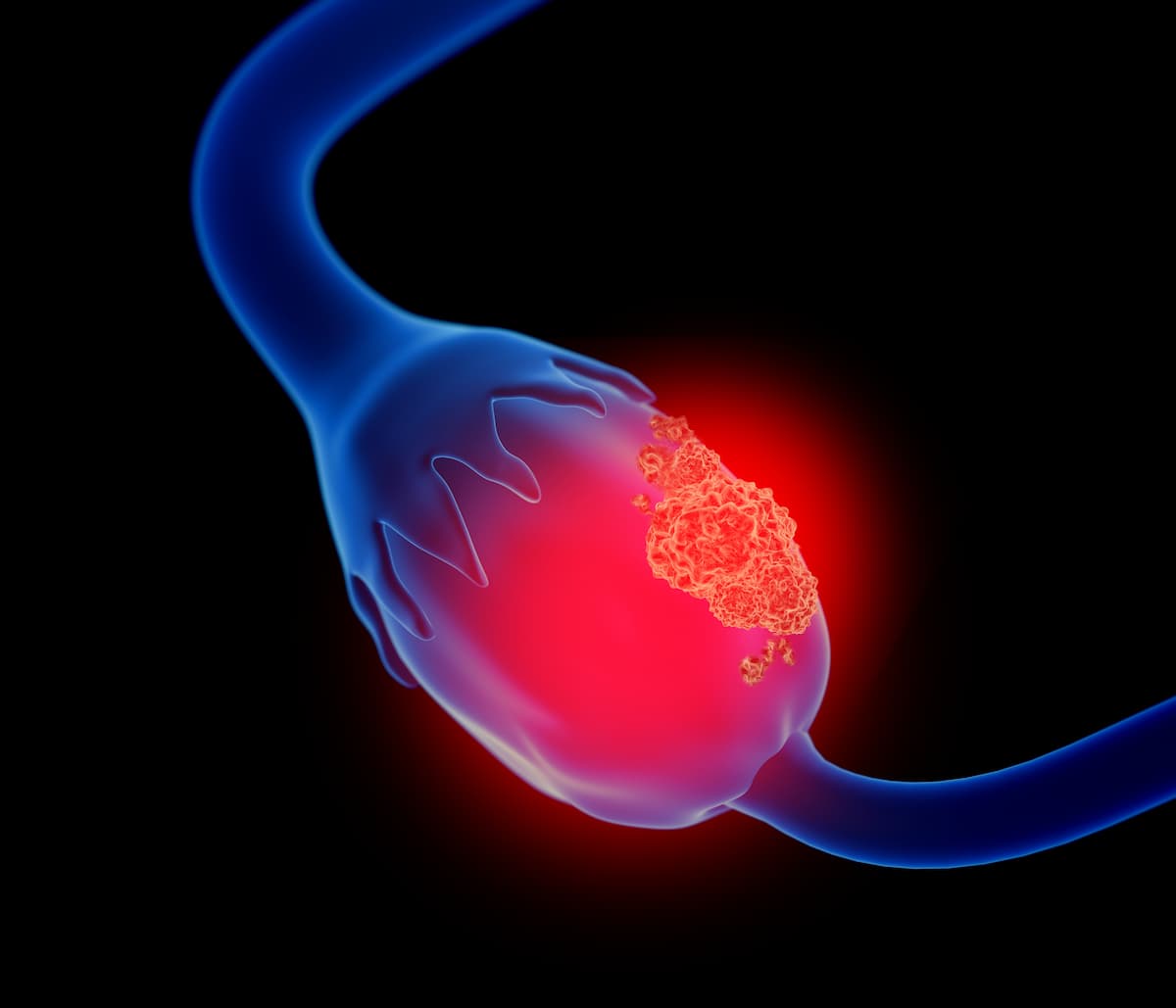Bevacizumab Regimen Yields Meaningful PFS Benefit in Ovarian Cancer
Maintenance bevacizumab plus durvalumab and olaparib appears to produce a progression-free survival benefit among those with HRD-negative advanced ovarian cancer in the phase 3 DUO-O trial.
"A PFS effect was observed across all subgroups for the [maintenance bevacizumab plus durvalumab and olaparib] vs [maintenance bevacizumab alone] comparison," according to an expert from Memorial Sloan Kettering Cancer Center.

Frontline chemotherapy plus bevacizumab (Avastin) and durvalumab (Imfinzi) followed by maintenance bevacizumab plus durvalumab and olaparib (Lynparza) demonstrated a statistically significant improvement, clinically meaningful progression-free survival (PFS) benefit vs maintenance bevacizumab alone in the treatment of newly diagnosed ovarian cancer without a BRCA1/2 mutation.
Results from an interim PFS analysis of the ongoing phase 3 DUO-O trial (NCT03737643), which were presented during a press briefing for the 2023 American Society of Clinical Oncology (ASCO) Annual Meeting, indicated that in a non–BRCA-mutant homologous recombination deficient (HRD)–positive tumor population, the median PFS was 37.3 months in the maintenance triplet arm vs 23.0 months in the maintenance bevacizumab alone arm (Hazard ratio [HR], 0.49; 95% CI, 0.34-0.69; P <.0001). In each respective treatment arm, the PFS rate was 90% vs 85% at 12 months; 84% vs 69% at 18 months; and 70% vs 46% at 24 months.
In the intent-to-treat (ITT) population, the median PFS was 24.2 months in the maintenance triplet arm vs 19.3 months in the maintenance bevacizumab alone arm (HR, 0.63; 95% CI, 0.52-0.76; P <.0001). In each respective treatment arm, the PFS rate was 81% vs 73% at 12 months; 71% vs 55% at 18 months; 51% vs 32% at 24 months.
In the ITT population, maintenance treatment with bevacizumab plus durvalumab yielded a median PFS of 20.6 months, which was an improvement compared with maintenance bevacizumab alone but lacked statistical significance (HR, 0.87; 95% CI, 0.73-1.04; P = .13). Maintenance bevacizumab plus durvalumab produced 12-, 18-, and 24-month PFS rates of 72%, 56%, and 39%, respectively.
Moreover, maintenance bevacizumab plus durvalumab and olaparib produced a median PFS of 20.9 months vs 17.4 months with maintenance bevacizumab alone in the HRD-negative population (HR, 0.68; 95% CI, 0.54-0.86).
Additionally, the median PFS with the maintenance doublet in those with HRD-positive disease was 24.4 months (HR, 0.82; 95% CI, 0.60-1.12), with corresponding 12-, 18-, and 24-month rates of 85%, 76%, and 51%, respectively. Moreover, the median PFS was 15.4 months (HR, 0.94; 0.75-1.18), with 12-, 18-, and 24-month rates of 63%, 42%, and 31%, respectively, in the HRD-negative population.
“A PFS effect was observed across all subgroups for the [maintenance bevacizumab plus durvalumab and olaparib] vs [maintenance bevacizumab alone] comparison,” presenting author Carol Aghajanian, MD, said.
According to Aghajanian, the chief of Gynecologic Medical Oncology Service at Memorial Sloan Kettering Cancer Center, investigators will reassess the HR for maintenance bevacizumab plus durvalumab compared with bevacizumab alone “at the time of the final PFS analysis.”
In the phase 3 DUO-O trial, patients with newly diagnosed stage III to IV high-grade epithelial ovarian cancer were randomly assigned to one of 3 treatment arms. In the chemotherapy phase of the trial, patients in the ITT population received chemotherapy consisting of carboplatin plus paclitaxel plus bevacizumab in arm 1 (n = 378) or chemotherapy plus bevacizumab and durvalumab in arm 2 (n = 374) and arm 3 (n = 378).
Patients were stratified based on cytoreductive surgery timing and outcomes, and geographical region.
In the maintenance phase, patients received bevacizumab alone for 15 months plus placebo in arm 1, bevacizumab for 15 months plus durvalumab for 24 months and placebo in arm 2, or bevacizumab for 15 months plus durvalumab and olaparib for 24 months in arm 3.
The primary end point was PFS per RECIST v1.1 criteria with maintenance bevacizumab alone vs maintenance triplet in the HRD-positive and ITT populations. Secondary end points included PFS with maintenance bevacizumab alone vs maintenance doublet in the ITT population, overall survival (OS), and safety.
Patients who received no prior systemic therapy for ovarian cancer were eligible for enrollment on the trial. Additional eligibility criteria included being PARP inhibitor or immune-mediated therapy naïve and undergoing primary debulking or planned interval debulking surgery. Investigators also stratified patients based on timing and outcomes of cytoreductive surgery and geographical region.
The median patient age was 59.0 years (range, 32-83) in arm 1, 58.0 years (range, 29-85) in arm 2, and 61.0 years (range, 21-84) in arm 3. Additionally, most patients in each respective arm were from Europe (66% vs 66% vs 66%), had stage III disease (63% vs 69% vs 67%), an ECOG performance status of 0 (64% vs 69% vs 69%), and high-grade serous disease (88% vs 87% vs 90%). Moreover, most patients had HRD-negative disease (57% vs 53% vs 56%).
The median duration of follow-up was 25.5 months (range, 0.0-44.8) in arm 1, 23.1 months (range, 0.0-42.6) in arm 2, and 23.3 months (range, 0.0-41.7). Across all arms, about 90% of patients received all planned cycles of chemotherapy.
The most common any-grade adverse effect (AE) was neutropenia, occurring in 44% of those receiving maintenance bevacizumab alone, 45% receiving maintenance bevacizumab plus durvalumab, and 51% receiving maintenance bevacizumab plus durvalumab and olaparib. Additionally, 20%, 26%, and 35% of patients in each respective group discontinued treatment due to AEs. Overall, the safety and tolerability of the study regimens were consistent with the known profiles of each individual agent.
“Data from the DUO-O trial at the time of this planned PFS interim analysis are important, and the trial is ongoing,” Aghajanian concluded. “Final PFS, OS, and other key secondary end points will be reported when available.”
Reference
Harter P, Trillsch F, Okamoto A, et al. Durvalumab with paclitaxel/carboplatin (PC) and bevacizumab (bev), followed by maintenance durvalumab, bev, and olaparib in patients (pts) with newly diagnosed advanced ovarian cancer (AOC) without a tumor BRCA1/2 mutation (non-tBRCAm): results from the randomized, placebo (pbo)-controlled phase III DUO-O trial. J Clin Oncol. 2023;41(suppl 17):LBA5506.
Newsletter
Stay up to date on recent advances in the multidisciplinary approach to cancer.